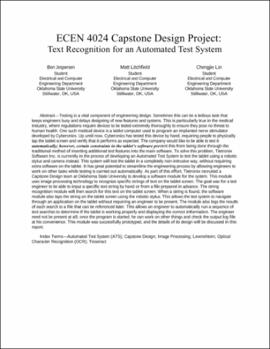| dc.contributor.author | Jespersen, Ben | |
| dc.contributor.author | Litchfield, Matt | |
| dc.contributor.author | Lin, Chengjie | |
| dc.date.accessioned | 2017-10-10T20:54:36Z | |
| dc.date.available | 2017-10-10T20:54:36Z | |
| dc.date.issued | 2016-04-26 | |
| dc.identifier | oksd_JespersenLitchfield_HT_2016 | |
| dc.identifier.uri | https://hdl.handle.net/11244/52280 | |
| dc.description.abstract | Testing is a vital component of engineering design. Sometimes this can be a tedious task that keeps engineers busy and delays designing of new features and systems. This is particularly true in the medical industry, where regulations require devices to be tested extremely thoroughly to ensure they pose no threat to human health. One such medical device is a tablet computer used to program an implanted nerve stimulator developed by Cyberonics. Up until now, Cyberonics has tested this device by hand, requiring people to physically tap the tablet screen and verify that it performs as expected. The company would like to be able to test it automatically; however, certain constraints in the tablet's software prevent this from being done through the traditional method of inserting additional test features into the main software. To solve this problem, Tietronix Software Inc. is currently in the process of developing an Automated Test System to test the tablet using a robotic stylus and camera instead. This system will test the tablet in a completely non-intrusive way, without requiring extra software on the tablet. It has great potential to streamline the engineering process by allowing engineers to work on other tasks while testing is carried out automatically. As part of this effort, Tietronix recruited a Capstone Design team at Oklahoma State University to develop a software module for the system. This module uses image processing technology to recognize specific strings of text on the tablet screen. The goal was for a test engineer to be able to input a specific text string by hand or from a file prepared in advance. The string recognition module will then search for this text on the tablet screen. When a string is found, the software module also taps the string on the tablet screen using the robotic stylus. This allows the test system to navigate through an application on the tablet without requiring an engineer to be present. The module also logs the results of each search to a file that can be referenced later. This allows an engineer to automatically run a sequence of text searches to determine if the tablet is working properly and displaying the correct information. The engineer need not be present at all; once the program is started, he can work on other things and check the output log file at his convenience. This module was successfully prototyped, and the details of its design will be discussed in this report. | |
| dc.format | application/pdf | |
| dc.language | en_US | |
| dc.rights | Copyright is held by the author who has granted the Oklahoma State University Library the non-exclusive right to share this material in its institutional repository. Contact Digital Library Services at lib-dls@okstate.edu or 405-744-9161 for the permission policy on the use, reproduction or distribution of this material. | |
| dc.title | ECEN 4024 capstone design project: Text recognition for an automated test system | |
| osu.filename | oksd_JespersenLitchfield_HT_2016.pdf | |
| osu.accesstype | Open Access | |
| dc.type.genre | Honors Thesis | |
| dc.type.material | Text | |
| dc.subject.keywords | automated test system (ats) | |
| dc.subject.keywords | capstone design | |
| dc.subject.keywords | image processing | |
| dc.subject.keywords | levenshtein | |
| dc.subject.keywords | optical character recognition (ocr) | |
| dc.subject.keywords | tesseract | |
| thesis.degree.discipline | Electrical and Computer Engineering | |
| thesis.degree.grantor | Oklahoma State University | |
